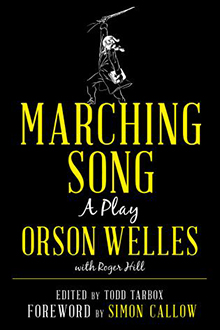
Summary
Marching Song is a play about the legend of abolitionist John Brown, written in 1932 by Orson Welles and Roger Hill. It is most notable for its narrative device of a journalist piecing together a man's life through multiple, contradictory recollections—a framework that Welles would famously employ in his 1941 film, Citizen Kane.[1]: 181 [2]: 222–223 Although the play has never been professionally performed, an abridged version of Marching Song was presented in June 1950 at the Woodstock Opera House in Woodstock, Illinois, a world-premiere benefit production by the Todd School for Boys. Rowman & Littlefield will publish the play in August 2019.[3][needs update]
| Marching Song | |
|---|---|
 First edition | |
| Written by |
|
| Original language | English |
| Subject | John Brown (abolitionist) |
| Genre | Historical drama |
History edit
In March 1932, two months shy of his 17th birthday, Orson Welles returned to Chicago from his post-graduation trip to Europe and his time with the Gate Theatre in Dublin.[4] Finding that he had few prospects despite his success in Ireland,[5]: 38–39 Welles persuaded Roger Hill, his former teacher and lifelong friend, to collaborate with him on a biographical play about abolitionist John Brown and his efforts to organize a slave revolt in 1859. In May, Welles visited Harper's Ferry and other historic sites with Hill, who was leading a two-week field trip for boys attending the Todd School.[2]: 218–219 In August, Welles retreated to Lac du Flambeau, Wisconsin, and stayed at the summer home of James B. Meigs and his family while he wrote the play.[2]: 220–221 Welles typed a cover page that credits the play as being by "Orson Welles and Roger Hill"; Hill said he wrote only a few scenes that Welles edited and reworked.[2]: 223, 226
"My own contribution to writing that play was a first draft of a first act," Hill recalled. "In other words, just enough to start our tireless boy off and, more importantly, send him off. Out of my hair."[6]: 119
Production edit
Though Welles's complete playscript for Marching Song has not been produced,[7] the Todd School for Boys presented an abbreviated world premiere of the play June 7–8, 1950, at the Woodstock Opera House. Hascy Tarbox, Welles's Todd School classmate and Hill's son-in-law, trimmed the four-hour play to two hours and staged the two performances for the benefit of the Woodstock Hospital.[8][6]: 119
Publication edit
A copy of the typescript, including Welles's sketches and set design instructions, is held by the Lilly Library at Indiana University in Bloomington, Indiana.[9]
On September 30, 1985, Hill told Welles that he had located his own copy of the play, which he planned to give him. "For my money it remains a compelling, if overly long, play. If that God-awful Hearts of Age … is worth saving, Marching Song, written two years earlier, should rate a Pulitzer. At least it's worth publication."[8]
Rowman & Littlefield Publishing Group of Maryland announced it will publish the play in August 2019 – 87 years after it was written. It will be accompanied by two essays written by Hill's grandson, Todd Tarbox, which put the work in historical context and examine Welles's progressive politics.[10]
References edit
- ^ Gilpin, R. Blakeslee (2011). John Brown Still Lives!. Chapel Hill: University of North Carolina Press. ISBN 9780807835012.
- ^ a b c d McGilligan, Patrick (2015). Young Orson. New York: Harper. ISBN 978-0-06-211248-4.
- ^ Welles, Orson; Hill, Roger (2019) [1932]. Tarbox, Todd (ed.). Marching Song: A Play. Rowman & Littlefield. ISBN 978-1-5381-2552-6. Retrieved April 3, 2019.
- ^ "Chicago Schoolboy Who Won Place on Dublin Stage Returns". Chicago Tribune. March 18, 1932. Retrieved 2016-07-21.
- ^ Brady, Frank (1989). Citizen Welles: A Biography of Orson Welles. New York: Charles Scribner's Sons. ISBN 0-385-26759-2.
- ^ a b Hill, Roger (1977). One Man's Time and Chance, a Memoir of Eighty Years 1895 to 1975. Privately printed; Woodstock Public Library collection, digitized by Illinois State Library. Archived from the original on 2014-09-07. Retrieved 2016-07-21.
- ^ Welles, Orson; Bogdanovich, Peter; Rosenbaum, Jonathan (1992). This is Orson Welles. New York: HarperCollins Publishers. p. 330. ISBN 0-06-016616-9.
- ^ a b Tarbox, Todd (2013). Orson Welles and Roger Hill: A Friendship in Three Acts. Albany, Georgia: BearManor Media. p. 270. ISBN 978-1-59393-260-2.
- ^ "Theatre, 1936–1947 (Box 5, f. 14-Box 7, f. 22)". Guide to the Orson Welles Materials in the Lilly Library. Lilly Library, Indiana University Bloomington. 6 December 2013. Retrieved 2016-07-21.
Purchased. Orson Welles, New York, N.Y., and Richard Wilson, Santa Monica, Calif. 1978.
- ^ "Orson Welles play 'Marching Song' set for publication". Wellesnet | Orson Welles Web Resource. 2019-04-02. Retrieved 2019-04-02.


